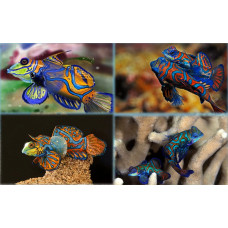Latin name
Synchiropus splendidus
Other names
Mandarin dragonet, mandarin goby, green mandarin, striped mandarinfish, striped dragonet, green dragonet.
Identification
Has a similar body shape to the goby, and this is the only similarity between the two. These fish have small elongated bodies, broad heads, bulging red and black eyes and plump blue lips. These fish are dimorphic - females and males develop differently. Male are larger than females and have exceptionally long spiny dorsal fins, making them easy to tell apart. In addition to razor-sharp spines, mandarins are covered in a toxic slime that taste and smell terrible.
Features of fish fins
The large pelvic fins are used for "walking" on the seabed and are often confused with pectoral fins. The dorsal fin is high in males.
Fish colouring
Have a bright colouring. The body is light blue with orange curls, the head is blue-greenish with light blue stripes. The orange curls are replaced by a more striped pattern on the pelvic, anal and caudal fins, which are outlined in blue. The dorsal fins also have a beautiful blue-orange pattern. The blue colouration is due to the cellular pigment. Eyes are usually red with black pupils.
Distribution
Occupies the Pacific Ocean, roughly from the Ryukyu Islands south to Australia.
Habitat
It is a marine fish that lives in warm tropical waters on shallow coral reefs and sheltered lagoons up to 18 metres deep, although it usually prefers the outer reef habitat.
Size
The size of the fish reaches up to 10 centimetres.
Behavior
They are slow moving and fairly common throughout their range but are not easily seen due to their bottom feeding habits and small size. They prefer to stay near the bottom of the reef, on sandy or muddy bottoms, and use live coral as a source of food and shelter, but are not dependent on it.
Food and feeding habits
Feeds on a mixed diet of harpacticoid paddlefish, polychaete worms, small gastropods, gammarid amphipods, fish eggs and ostracods. In the wild, feeding is continuous throughout the day, with fish selectively feeding on small prey trapped on coral substrate within a home range of many square metres.
Reproduction
With a maximum length of 8 cm, the fish reaches sexual maturity at 3 cm or 14 months of age. The male is brightly coloured and displays its long dorsal fin to impress the female during courtship. Pairs attach their pelvic fins as they rise to the surface where eggs and sperm are released. During the peak season, females lay eggs once a night or every few days, producing between 12 and 205 pelagic eggs from which larvae hatch. Mandarinfish do not monitor or guard their eggs. Within nine days of hatching, the young settle in a small area on the reef, where they remain for about a month. They live for 10 to 15 years.
Fishing
The popularity of these fish is causing populations to decline in regions such as the Philippines.
Relationship with a person
Beautiful patterns make these fish a favourite with aquarists.
They are peaceful fish and pose no threat to humans, but have sharp spines and poisonous slime that can cause injury if handled.
| Classification | |
| Phylum | Chordata |
| Class | Actinopterygii |
| Squad | Callionymiformes |
| Family | Callionymidae |
| Genus | Synchiropus |
| Species | S. splendidus |
| Features | |
| Conservation status | Least Concern |
| Habitat | Pelagic |
| Life span, years | 15 |
| Maximum body weight, kg | No information |
| Maximum length, cm | 10 |
| Sailing speed, m/s | No information |
| Threat to people | Not edible |
| Way of eating | Predator |
Mandarinfish
Tags: mandarinfish



